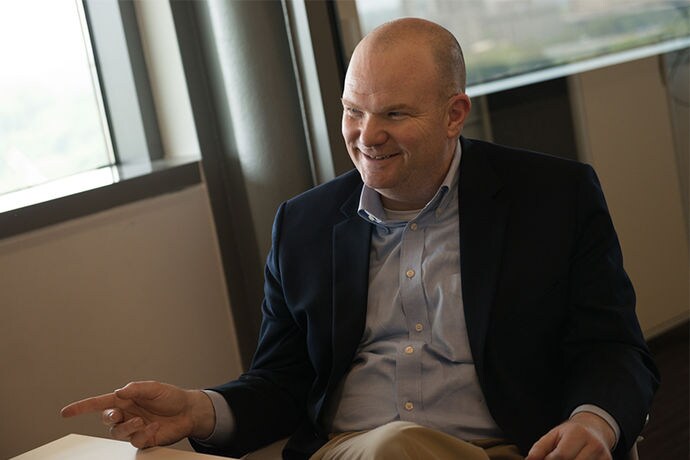
Lone Star Turnaround
Texas is in the midst of an ambitious effort to spread its school turnaround successes statewide. Two principals and a state education leader share what they’re learning by doing.
One of every 10 kids America now goes to school in Texas, which counts 4 cities among the nation’s 11 largest: Dallas, Houston, San Antonio, and Austin.
This past spring Teach For America gathered 44 alumni principals and school district leaders for a weekend in Austin to study the principles of human-centered design. That Sunday, Martin Winchester (R.G.V. ’95), deputy commissioner for educator support at the Texas Education Agency (TEA), issued a challenge to these members of TFA’s Texas Alumni Collective: Give me your best design ideas for how to lift every Texas school out of failing status—known in Texas as IR or “Improvement Required.”
Three years ago, the Texas legislature started pressuring school districts to close failing schools by limiting the number of years a school could fail, and limiting the percentage of failing schools a district could host before triggering a state takeover. Since then, under TEA leaders including Penny Schwinn (Baltimore ’04), chief deputy commissioner for academics, the state has changed how school health is measured.
Texas moved away from framing student performance on state exams to make it look as if almost all kids were proficient, to creating more clearly articulated levels of proficiency. Now the state tells parents if their kids are meeting minimum academic standards (called “Approaching” grade level); are at grade level (called “Meets”); or have reached “Mastery.” To avoid the IR label, schools must consider and address student performance at all three levels: Approaches, Meets and Masters. In 2019, Texas will begin grading schools A through F based on student achievement, school progress, and closing achievement gaps.
As this was evolving, Schwinn and her team redesigned digital school and student report cards to strip out the jargon and show parents in what subjects their children are (or are not) progressing; how each student compares, subject by subject, to others in the state; and where students can find tailored online study resources. As an example, a family can upload a student’s performance and interests into an education department site, and the site will generate a book list families can bring to the local library.
With the new report cards, “we’ve moved from ‘Did I pass?’ to a much richer discussion around Approaches, Meets, and Masters,” Winchester says, “and transferred ownership to students of their own progress.”

Two years ago, Texas Education Commissioner Mike Morath recruited Winchester to lead educator support for the state of Texas and oversee school improvement. Winchester has spent most of his career teaching in the Rio Grande Valley, 10 years in his placement district and 9 years at IDEA Public Schools, where he split his tenure between teaching and supervising principals. Stepping into the deputy commissioner’s job, which covers everything to do with recruitment, preparation and certification of teachers and school leaders, Winchester felt he had a lot to learn.
He’s been crisscrossing Texas, visiting giant districts and tiny rural towns where some struggling schools are reliant on permanent substitutes, looking for the commonalities within thriving and failing schools. Winchester has videotaped exemplary principal supervisors at work. “I held that role at IDEA, and I believe principal supervisors can be a huge lever for principals in helping with how they spend their time,” he said.
In person, Winchester softens his aura of intense concentration with an easy laugh. On a recent Tuesday afternoon, in a light-filled conference room at Austin’s new and majestic Central Library, he sat down to learn from two alumni principals who are turnaround specialists. The three let One Day listen in on their conversation (which has been edited and condensed for this report).
Eric Tingle, who grew up in a small town in Oklahoma, came to Houston as a corps member in 2006. The first neighborhood school he was offered to lead as a principal was Foster Elementary. “When I got there, my school was the 8th lowest elementary school in the district, out of about 170. I wondered, “Why would they do that to a new principal?” He led the school out of IR status in three years, earning five distinctions by year four. In February he was recruited to be the principal of Tinsley Elementary, a 730-student neighborhood school that has been in IR status in the past.
Heather Holland began teaching first grade in her hometown with the Dallas-Fort Worth charter corps in 2009 and later became an assistant principal at L.V. Stockard Middle School. Then as a first-time principal, she led a middling Dallas elementary to distinguished status. In July, she was recruited back to Stockard to be its principal, and bought a house two minutes away from the school in the South Dallas neighborhood of Oak Cliff.
When she arrived, the school had just scored 62nd out of 63 Dallas secondary schools in the school culture portion of the school climate survey. Thirty fed-up teachers had left in one year. “It was really in a downward spiral, with the community not believing in the school,” she says. “We have about 1100 kids, and 96 percent living in poverty. But there are a lot of homes in the neighborhood that generations of the same family have lived in, and a lot of my students’ parents went to my school. I know this community. It doesn’t have to be this way.”
Winchester kicked off their conversation by asking about the challenges of leading a turnaround. As a principal, where do you start?
Eric Tingle: So I think part of the challenge of being a turn-around principal is the unknown. What are the best practices, what do you need on your team to be able to do this? One of the things that I tell people all of the time is that we pretty much learn to turn the school around by trial and error. I think that principals should be provided with some sort of toolkit, if you will, of best practices that will potentially guide that work.
I think one of the things that we definitely have to work on—that principals have to be trained on—is how to build culture in a tough school, especially in a district like Houston ISD where teachers can transfer throughout the district. What is it that you need to do to get the best teachers to come to your IR campus? Teachers will move mountains for you if they know they’re loved and cared for and they’re part of the decision-making. But they have to want to be there.
And in a turnaround school, teachers have to know how they’re held accountable. You would be surprised how many teachers don’t know about the “Approaches,” the “Meets,” and the “Masters,” and some principals don’t know the system either. People fail from lack of exposure to what they’re accountable for. You flat-out have to teach the accountability system.
And one of the first things I’m implementing on the current campus I’m on now is monitoring instructional time and moving towards giving every teacher a minute-by-minute schedule. It took me about two years on my first campus to understand how much instructional time was being wasted. When you have kids on your campus who are two or three grade levels behind, instructional time needs to be more, not less. But people were spending so much time transitioning, it was ridiculous. Of course you may have kids walking slowly down the hall. But if a teacher knows that she needs to start the lesson at 11:05, she’s going to get those kids down the hall.
But you have to invest teachers in what’s going on and the root cause of it, and make them part of the planning. People like structure, they really do. They just don’t want to be told to do it.

Heather Holland: I agree. When you walk into an IR campus, there is dysfunction. My job walking in is to find the dysfunction, diagnose it, and figure out things to do to make it work.
For me, the first job was building trust. We had 20 percent of teachers agreeing that discipline was effective on campus. We had 900 disciplinary referrals in the first semester of school in 2015, and hundreds of in-school suspensions. Can you imagine the time lost? I was told that kids would roam around the school and not go to class. It’s not funny, but it’s kind of funny because they’re seventh graders. I think we can tell them to go back to class, you know?
Before school started I met with more than 40 staff members and I asked the same questions. What do you love about our school? What would you change about our school? Why are you here? I needed to know what was working so we could have some quick wins. Then we did focus groups for the parents and the students. Do you feel safe at school? Is this a school you would recommend for other students or for parents?
That was an eye-opening experience. I was able to put all that data together and present it to my staff the first week of school before students showed up: “This is what you guys said.” That was really important because in a dysfunctional school, people don’t communicate with one another. We spent that first whole week of professional development on culture. I took my whole 120-person staff and we did privilege walks to see where people are and how they got there.
I started putting out an early email every day called the Daily News, because teachers want to know what’s happening—who’s out, do we have a fire drill today? I started doing observations and feedback, but I said to teachers, “You’re going to know when I’m coming, because I want to see you at your best. I’m going to give you feedback on your best and talk about how we’re going to improve that for next time.”
Creating trust and transparency was so important. Any time an assistant principal is out, I choose a teacher, I give them a radio and say, “You’re helping us today,” because I want them to see the other side. Sometimes there’s a very “us vs. them” mentality.
Martin Winchester: In my first summer here on the job, I started to think through what kind of professional development most schools were getting. And when I talked to some turnaround principals, it was heartbreaking. I heard things like, “I’d love to get PD, but I’m in turnaround.” The narrative was, “I’m barely keeping my head above ground just to meet compliance expectations.” That made me think about how we’re setting up principals and their supervisors for a turnaround effort that is supportive.
Winchester described how his TEA team is piloting professional development experiences for principals and their supervisors to shift the agency’s role from ensuring compliance to giving support.
Winchester: [TEA works with] 20 service centers with over 4,000 employees across the state. Those service centers are the largest providers of PD in the state of Texas. So how can we capitalize on what they’re already doing well with teachers, and how can we introduce them to methods of instructional leadership for principals and their supervisors around coaching and data-driven systems? We’ve had fellows from each of those 20 service centers come to these types of trainings.
What I heard from both of y’all is that y’all have got to know your schools. You wanted to raise awareness in your schools about why are we in IR, and how are we going to get out of IR. We are in the process of refining our tools and picking up from practitioners like yourselves what works, what doesn’t, and what advice you would have for other principals about what it takes to turn around schools.
I’ve seen those pockets of excellence, but we still need, in some transferable form, to get that road map to more principals. Because you can go down a rabbit hole trying something for six or seven months before someone says, “Hey listen, you should worry about that in year two or three. Year one, this is the place where you should start to double down.”
I know people say, “Hey, every school is unique.” But this should not be a guessing game.
What we’re trying to do in the certification process is redesign it so that principal prep programs have to adjust and build those skills. The very first certification process that we’re redesigning [at TEA] will be the principal certification. And we know the next generation of principals will be better prepared because our certification requirements have been raised, and we certify between 5,000 and 7,000 principals a year in Texas.
Tingle mentioned that he interviewed 60 principals for his doctoral dissertation.
Tingle: A large portion of them said that the best thing that can happen for them is putting them on the ground with somebody giving them feedback. Not going to a meeting at the district. Not reading an article online. None of that other stuff they ask us as principals to do—most of that doesn’t matter to principals. Put them in a school and give them a supervisor who knows what to do with that school.
The conversation turned to how schools have moved from being measured primarily on how many students passed state tests.
Holland: I really like this change to Approaches, Meets, Masters. I feel like some of our teachers have the mentality of preparing students just to be OK, because that’s how we were judged, and you perform to your goal, right? Even as a teacher I was probably guilty of that because I took for granted, “This kid’s doing great, he’s going to be fine, I don’t need to push him that much.” I feel like sometimes our higher-performing students were left behind because we weren’t growing them as much as we could have.
I really saw a difference this year after we trained our teachers that you don’t have “bubble” kids anymore. Every single one of your kids needs to show growth. We’ve been measuring on this domain all year, the average of students at Approaches, Meets, and Masters. My “Meets” grew by 5 percent in one month after I trained my teachers, because they now know we need a growth goal for every kid.

Holland said because of where the school started the year with student outcomes and how far below grade level many students are, she is bracing for the school to get a low letter grade.
Holland: Now, I think that’s going to be hard for us. Don’t get me wrong. But I do think it’s going to be a far more accurate view of students’ college readiness on every campus.
Winchester: I’m incredibly motivated by what you’re saying, Heather. There’s going to be a lot more investment and ownership from students asking, “Where am I on this bar?” Under the old system, what is the one thing that students wanted to know? “Hey teach, did I pass?” And then it’s time for the ACT, and what is the one thing on their mind that they want to know? “Did I pass?” There’s no such thing as passing the ACT. You have kids coming in with a low score of 16, saying, “You’re telling me now, in 11th grade, that there’s no such thing as passing?”
Now we can have that conversation all along the way with a parent. Your kid is at “Approaches” so he’s passing, but guess what? He’s not at grade level, and here’s what we can do about it. That changes the narrative in this state.
As the conversation neared its end, Winchester posed a question to the principals: Were you coached on how to deploy the new accountability system?
Tingle: I think professional development and supervision in education is like any other sector in that people coach you on whatever the hot topic is. When the accountability system came out, it was a hot topic, but I think it’s kind of died down. I personally had the conversation with teachers as soon as I got to Tinsley Elementary, but only because I knew I had to do it, not because someone told me or coached me on it. Having been in an IR school for four years, I had that background.
Winchester: The reason I ask is that I have visited IR campuses across the state. I’ve seen a lot of gaps in principals’ knowledge of the accountability system. I have even visited with superintendents where I say, “Hey, what are some of the big reasons you’re in IR?” They say, “Everything.” I ask, “Really? Is it math specifically? This grade or that teacher?” It gets really uncomfortable, and I usually back off because my role is not to hit someone with a hammer, it’s to shine a flashlight to ask, “Where do we start?”
I know in my heart these principals are working an equal amount of hours as you two. I have not found lazy principals. I have not found lazy superintendents. I have found educators who are trying as hard as they can, and what goes through my mind is the gap between those leaders and the best practices.
The best practices are out there. It takes a lot of work. It takes the right teams, and the right people, and the right support. But it can be done. That’s what I continue to believe, and now we have to figure out how to spread it.
This piece was edited by Susan Brenna.
Sign up to receive articles like this in your inbox!
Thanks for signing up!
Content is loading...


